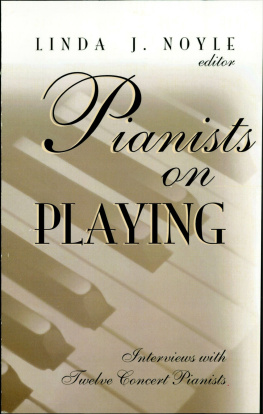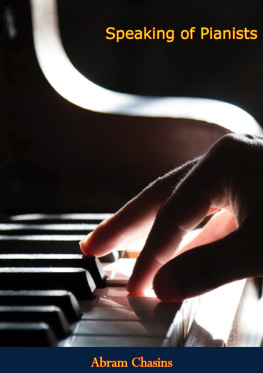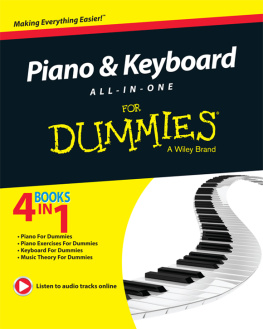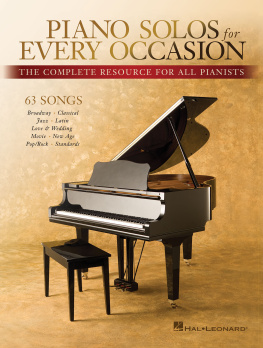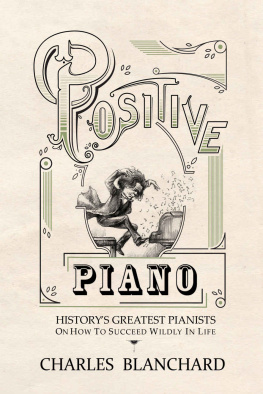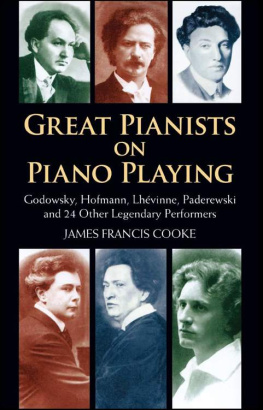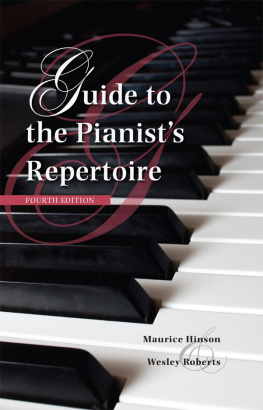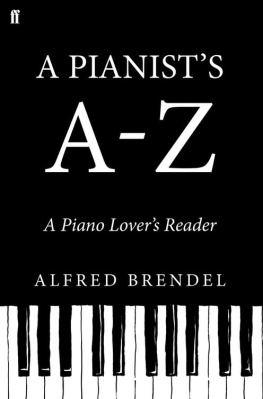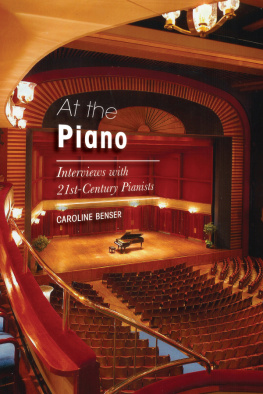Table of Contents
Guide
Beethoven | Ludwig van Beethoven |
Brahms | Johannes Brahms |
BWV | Bach-Werke-Verzeichnis |
ca. | Circa; approximately |
Chopin | Fryderyk (Frdric) Chopin |
Curtis | Curtis Institute of Music |
Debussy | Claude Debussy |
e.g. | Exempli gratia (Latin); for example |
Eng. | English |
Fr. | French |
Ger. | German |
Haydn | Joseph Haydn |
It. | Italian |
J. S. Bach | Johann Sebastian Bach |
Juilliard | The Juilliard School |
K. | Kchel (for Mozart) or Kirkpatrick (for Scarlatti) |
L | Left |
L.H. | Left hand |
Lat. | Latin |
Liszt | Franz Liszt |
mm. | Measure |
mms. | Measures |
Mozart | Wolfgang Amadeus Mozart |
No. | Number |
Op. | Opus |
Peabody | Peabody Conservatory of The Johns Hopkins University |
Pol. | Polish |
Port. | Portuguese |
R | Right |
R.H. | Right hand |
S. | Searle catalog |
Sp. | Spanish |
U.S. | United States |
WoO | Work without opus |
THE
Pianists
Dictionary

Second Edition
THE
Pianists
Dictionary

Second Edition
This book is a publication of
Indiana University Press
Office of Scholarly Publishing
Herman B Wells Library 350
1320 East 10th Street
Bloomington, Indiana 47405 USA
iupress.indiana.edu
2020 by Margaret Hume Hinson and Wesley Roberts
All rights reserved
No part of this book may be reproduced or utilized in any form or by any means, electronic or mechanical, including photocopying and recording, or by any information storage and retrieval system, without permission in writing from the publisher. The paper used in this publication meets the minimum requirements of the American National Standard for Information SciencesPermanence of Paper for Printed Library Materials, ANSI Z39.48-1992.
Manufactured in the United States of America
Cataloging information is available from the Library of Congress.
ISBN 978-0-253-04731-1 (hdbk)
ISBN 978-0-253-04732-8 (pbk)
ISBN 978-0-253-04735-9 (web PDF)
1 2 3 4 5 25 24 23 22 21 20
In Memoriam
Maurice Hinson
(19302015)
CONTENTS

T HE TASK OF TODAYS LEXICOGRAPHER IS A DAUNTING one when considered in light of the sheer abundance of information available. Nowhere else is this more true than for pianism, a domain now in its fifth century. Early piano builders could have never imagined the developments in manufacturing, piano literature, performance, and audience enthusiasm that have emerged in the centuries since that time. The pianos humble beginnings, emancipating from the action of the clavichord and embodying the form of the harpsichord, opened new doors of musical expression that have inspired composers, performers, and audiences throughout the ages, as they continue to do today.
This second edition of The Pianists Dictionary follows the trajectory established in the first edition. Its aim is to provide the reader with a general reference guide to musical terms, selected compositions, composers, performers, treatises, and manufacturers of the piano. No one book could possibly contain all there is to be said, and readers are asked to be understanding if a favorite composer or performer does not appear.
This book is the first in Maurice Hinsons immense series on the piano to be published since his passing. It was my privilege to study piano with Hinson in the late 1970s at the Southern Baptist Theological Seminary and to serve as his student assistant. These were the early days in his editorship of the Journal of the American Liszt Society. Hinson would occasionally send me to the library to search for details related to Liszt, and occasionally I managed to find information that had eluded him. I imagine this was one of the reasons he entrusted me as coauthor of a new edition of The Piano in Chamber Ensemble (2006), the first in what has become a series of collaborations. Hinson was always interested in promoting music in the United States: readers of his works will notice a stronger emphasis on American composers and their music than is often found in other writings on piano literature. This approach was instilled in him early on and manifested itself in a series of three lecture-recitals he toured with early in his career tracing the development of the piano and piano literature in America. That it spilled over into his many publications should be no surprise.
Assisting me in the preparation of this volume has been my wife, Sida, whose linguistic skill in several European languages aided me on many occasions. For her assistance I am most grateful. Readers will find that some foreign terms may be translated in multiple ways. I have taken every precaution to interpret these in a musical context. Any errors herein are my responsibility. I am also thankful for the assistance of my colleague James W. Moore, who digitized musical illustrations, and to Kay Alston, librarian, and her staff at Campbellsville Universitys Montgomery Library for providing materials in the preparation of this edition.
December 2018
Wesley Roberts
Campbellsville, Kentucky
T HIS MUSIC DICTIONARY AIMS TO ASSIST THE PIANIST in all aspects of his or her art. It is a practical guide that covers definitions of terms, performance directions, names of well-known piano pieces, nicknames of pieces, forms, and styles, plus brief biographies of leading pianists, composers of piano music, and piano manufacturers as well as parts of the piano (action, soundboard, etc.) and neglected repertoire the author feels is important. I have also included the names of some college and university faculty members who are outstanding teachers, performers, or both, or who have made some unusual contributions to the piano world by their writing or editing. It is impossible to include some of the most interesting instructions from composers: Satie suggested the pianist should play like a nightingale with a toothache; Messiaen urged the performer to sound like someone sharpening a scythe.
To be sure, there is more to interpretation than just recognizing the terms. The pianist has to know that allegro means a style as much as a tempo and that a Brahms grazioso is quite different from a Mozart grazioso. This dictionary aims to help with the other part of the meaning besides speed and tempo.
Next page

